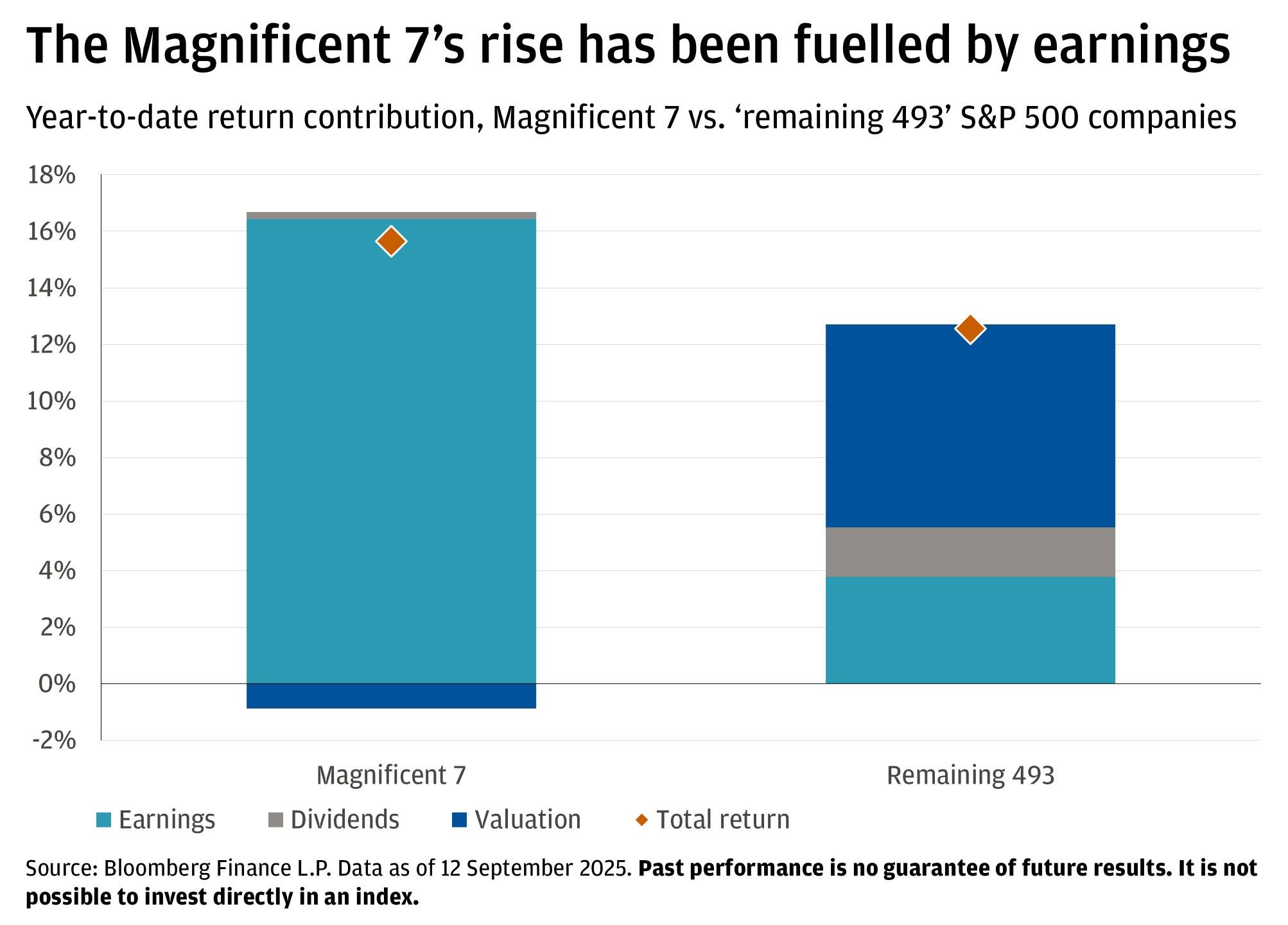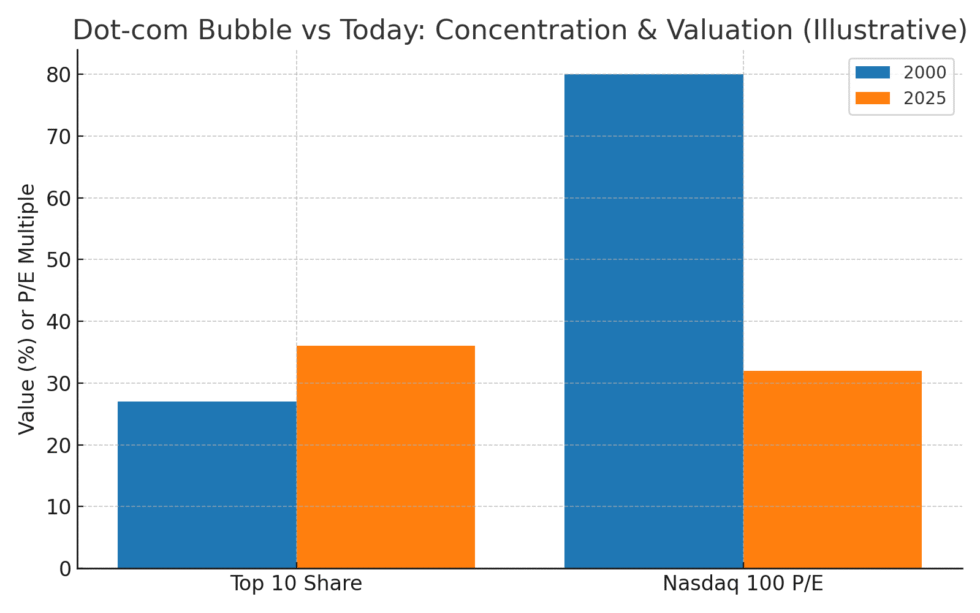TradingKey - Recently, I ran into my old neighbor Linda at a coffee shop. She’d been retired for just three months, yet she looked more anxious than she ever did during her working years.
“I’m torn every day about whether to sell that AI fund,” she said quietly. “My account shows over $400,000 in unrealized gains—all thanks to Nvidia, Microsoft, and a few other companies. But now, I have to take a deep breath just to check my portfolio.”
At 62, Linda had expected retirement to be a time of peace and enjoyment. Instead, what was supposed to be a “set-it-and-forget-it” index investment had become a source of constant stress. Her S&P 500 index fund had delivered stunning returns over the past two years—but only recently did she realize: nearly all of that growth was being driven by just seven AI-focused giants.
“I managed to avoid the dot-com crash back in 2000,” she said. “But now I’m starting to wonder—am I facing a similar situation again? Only this time, even ‘passive investors’ like me aren’t safe.”
Her concern isn’t unfounded. In 2025, AI-related stocks now account for nearly half of the total market capitalization of the S&P 500—a historic high. This means that even if you never intentionally bought an AI stock, simply holding a mainstream index fund has already exposed you deeply to the AI theme.
To be sure, artificial intelligence is transforming the economy—much like the internet once did. But history also reminds us: not every company flying the “AI” banner is built to last, and not every surge in price will survive the test of time.
Many investors are now questioning whether to stay invested—worried that if the AI hype cools, years of hard-earned paper gains could vanish overnight.
The answer may not lie in whether AI will succeed, but in how wisely you choose to participate in this transformation—capturing opportunity without putting all your eggs in one basket.
Is AI Really Dominating the Entire Stock Market?
In 2025, the S&P 500 has risen by more than 16% year-to-date, and this rally has been driven almost entirely by artificial intelligence (AI).
Nvidia’s market cap recently surged past $5 trillion. Tech giants like Amazon, Microsoft, Meta, and Alphabet have all delivered earnings that beat expectations—largely fueled by AI.
According to J.P. Morgan, just 41 AI-related stocks—representing approximately 8% of the index’s constituents—now account for 47% of the S&P 500’s total market capitalization, a record high. In contrast, the remaining 459 stocks (92% of the index) make up only 53% of its total value.
These 41 companies include 29 core AI firms—such as Nvidia, Microsoft, Apple, Alphabet, and Amazon—as well as 8 AI-focused utility companies and 4 hardware manufacturers.
Macro researcher Jim Bianco points out that since ChatGPT’s launch in 2022, these 41 stocks have contributed 74% of the S&P 500’s total gains, while the other 459 stocks combined accounted for just 26%.

And the investment momentum continues to accelerate.
Meta plans to spend $66–72 billion on AI infrastructure in 2025, with even higher spending expected in 2026. Nvidia forecasts that global AI infrastructure investment will reach $3–4 trillion by 2030. Spending by hyperscale data center operators is projected to grow 44% in 2025, hitting $370 billion, and surpassing $400 billion in 2026.
Just six companies—Microsoft, Apple, Nvidia, Alphabet, Amazon, and Meta—now represent nearly one-third of the S&P 500’s total market cap. Add Tesla and other large-cap names, and the top 10 companies alone account for over one-third of the entire index.

(Source: Shutterstock)
This means that even if you’ve never actively invested in AI, your wealth is already deeply tied to this theme—simply by holding an S&P 500 index fund.
For investors who believe in diversification, this raises a critical question: When the index itself is highly concentrated in a single, still-evolving technological narrative, do you truly have the diversification you think you do?
Are We Heading Toward a Bubble in the AI Boom?
An increasing number of investors are growing cautious: as markets repeatedly hit new highs—powered almost entirely by artificial intelligence–related stocks—is this the inevitable result of a technological revolution, or a sign of irrational exuberance?
Lisa Shalett, Chief Investment Officer at Morgan Stanley Wealth Management, notes that today’s market rally is “almost entirely dependent on massive capital spending on generative AI,” creating what she calls a “monolithic narrative.” She candidly warns: “If AI investments ultimately fail to deliver productivity returns, the consequences could be severe.”
She even draws a parallel to Cisco in 2000—the company that once held the title of the world’s most valuable before its stock plummeted 80% after the dot-com bubble burst. When asked when similar risks might reemerge, she said probably not in the next nine months, but very possibly in the next 24. Using a baseball analogy, she added: “We’re a lot closer to the seventh inning than the first or second inning.”
Market concentration in a few dominant stocks is not new. In the 1960s–70s, the “Nifty Fifty” blue chips—like IBM and Coca-Cola—dominated index weightings. In the early 2000s, energy stocks surged on the back of a commodity supercycle. And in the late 1990s, internet and telecom companies briefly ruled the market.
But today’s situation is markedly different: the combined weight of the S&P 500’s top 10 constituents has now surpassed all previous records.
On the surface, the current environment does resemble the 2000 dot-com bubble—tech stocks leading the charge, high valuations, and elevated investor sentiment.
Back in 2000, many “.com” companies had little to no revenue, unproven business models, and valuations based on “eyeballs,” “clicks,” and promises of future growth. When the bubble burst, countless firms vanished overnight, and the leaders of the S&P 500 were swiftly replaced.
Today’s tech giants, however, are somewhat different.
Microsoft, Apple, Alphabet, and Amazon rank among the world’s most profitable companies, collectively generating hundreds of billions of dollars in annual free cash flow. Nvidia has become the cornerstone of AI infrastructure, with its data center revenue growing at an unprecedented pace. After setbacks in the metaverse, Meta has roared back into high growth—driven by AI-enhanced ad efficiency and disciplined cost controls.
In terms of valuation, leading tech stocks today trade at price-to-earnings (P/E) ratios mostly between 25x and 40x. While elevated, this is far below the extreme 70x–100x P/E levels seen in the Nasdaq-100 during 2000. More importantly, today’s high valuations are partially supported by sustained revenue growth, high profit margins, and strong capital returns.

(Source: Investments for Expats)
Is Your Portfolio Truly Diversified?
The core issue isn’t whether “AI is great,” but this: when nearly half of the S&P 500’s market value is driven by just a few dozen AI-related stocks, is your so-called “diversified” portfolio still genuinely diversified?
True diversification goes beyond holding assets across multiple sectors or regions—it must also align with your current financial stage, income stability, and personal risk tolerance.
If you’re nearing retirement and a large portion of your wealth is passively tied to highly volatile tech stocks—even if their fundamentals are strong—a deep market correction could disrupt your withdrawal plan.
Conversely, if you’re still in your accumulation phase, with stable income and a 20–30-year investment horizon, moderately embracing AI-driven growth may be reasonable. Yet you must still guard against “pseudo-diversification”—for example, holding multiple tech funds that all heavily overlap in Nvidia, Microsoft, and similar names. It may look diversified, but in reality, it’s highly concentrated.
Ask yourself: Can you sleep soundly during market turbulence and stick to your investment discipline?
If you have a high tolerance for volatility, you can maintain an equity-heavy long-term portfolio—but consider diversifying within equities. For instance, add exposure to sectors like financials, energy, or defense industries benefiting from fiscal expansion and deglobalization trends—to reduce reliance on mega-cap tech.
If market swings easily unsettle you, consider adding balancing assets like bonds or gold. Gold typically has low correlation with stocks during bull markets but often provides an effective hedge during crises. Many prudent investment strategies—such as the Stadswaard Composite Strategy—typically allocate around 7% to gold to enhance long-term risk-adjusted returns.
If you lack experience analyzing individual stocks, participating through an AI-themed ETF is a more convenient and risk-controlled approach. ETFs offer instant exposure to a diversified basket of AI-related companies, reducing single-stock risk while saving you the effort of stock picking.
Like many others, you may worry that the AI “gold rush” has inflated valuations and fear a pullback is imminent. But acting out of fear—by moving all your money into a bank account—may feel safe while actually being dangerous. In a climate of falling interest rates and persistent inflation, cash quietly loses purchasing power, eroding your wealth over the long term.

(Source: Shutterstock)
The Bottom Line
The weight of AI-related stocks in the S&P 500 has climbed to a historic high—a testament to the transformative power of technology, but also a quiet seed of concentration risk. For you, the real challenge isn’t whether AI will change the world, but how to strike a balance between enthusiasm and caution.
A rational strategy isn’t about chasing rallies or fleeing in panic—it’s about staying meaningfully engaged while actively broadening your diversification across sectors, regions, and asset classes. Through thoughtful asset allocation and disciplined risk management, you can capture the upside of the AI revolution without being swept away by the volatility of a single narrative.
As the old investing adage goes:
“Bulls grow on doubt, and die in euphoria.”
Today’s AI wave may still be in its prime—but for you, staying clear-headed will always be more valuable than chasing the latest hype.


